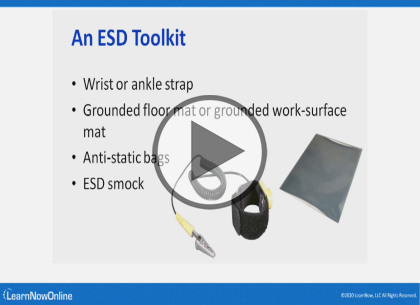1001-02: CompTIA A+ Certification, Part 2 of 13: Best Practices
with experts Brian Ferrill, Chuck Nailen
Course description
In this course for the CompTIA A+ 1001-1002 exam, we will be looking at the various hardware and software tools that an A+ technician should be able to use. Then we’ll be looking at Electrical Safety, what are the best practices and tools you should use. Then we’ll cover what you need to do as an A+ technician to control your company’s impact on the environment. Then we’ll cover at issues of professionalism and Communication. As an A+ technician, you will find there will be many times you need to deal with angry customers.
Prerequisites
This course assumes the user has little to experience with computer hardware or software
Learning Paths
This course will help you prepare for the following certification and exam:
CompTIA A+ Certification
Meet the experts
A lifelong fascination with technology led a varied career in technology. I have over 20 years of experience supporting end users, and small businesses. On top of that, I have been an Information Technology instructor for Edmonds Community College, where I instructed on CompTIA’s A+, and Network+ material. During that time I created curriculum for not only those courses, but also for CompTIA’s Security+ certification. I currently hold the following certifications: A+, Network+, Server+, Cloud+, and Project+.
Chuck Nailen has been providing classroom training for more than 16 years. He does training for in department-supported CompTIA curriculums, Microsoft curriculums, and Department of State (DoS) proprietary platforms in support of SAIT and DoS programs. He holds many certifications including National Career Readiness Certificate-Gold Level, MCSA, MCT, MCITP, MCTS, and others.
Course outline
Best Practices
Basic Maintenance Tools (21:40)
- Introduction (00:21)
- PC Technician Best Practices (00:25)
- Types of Hardware Toolkits (02:39)
- Software Diagnostic Tools (01:17)
- Hard Drive Self-Tests (01:08)
- Software Diagnostic Tests (01:44)
- Component Maintenance (01:28)
- Cleaning Compounds & Materials (00:58)
- Documentation and Resources (01:38)
- Compliance & Gov't Regulations (00:43)
- Demo: Tools (02:41)
- Scripting Basics (03:14)
- Basic Script Constructs (02:56)
- Summary (00:23)
Electrical Safety (18:49)
- Introduction (00:19)
- Static Electricity (02:05)
- ESD (00:38)
- ESD Prevention Techniques (01:53)
- EMI (00:31)
- EMI Prevention Techniques (01:53)
- An ESD Toolkit (01:51)
- Electrical Hazards (03:25)
- Electrical Safety Precautions (03:42)
- Demo: Electrical Safety (02:09)
- Summary (00:18)
Environmental Issues (22:24)
- Introduction (00:23)
- Environmental Considerations (04:06)
- Workplace Safety Issues (06:00)
- Environmental Best Practices (03:08)
- General Power Issues (01:25)
- Power Protection Systems (02:02)
- Liquid Hazards (00:28)
- Chemical Hazards (01:29)
- MSDS Documents (00:31)
- Incident Reports (00:37)
- Hazardous Material Disposal (01:47)
- Summary (00:23)
Professionalism & Communication (37:41)
- Introduction (00:25)
- Communication Skills (04:48)
- AUP (01:14)
- Inventory Management (03:03)
- Licensing (04:12)
- Professional Conduct (04:37)
- Internet Security Appliances (03:29)
- Secure Endpoint Management (01:27)
- Prohibited Content (00:41)
- Prohibited Content Best Practices (01:47)
- Computer Forensics (02:52)
- Change Management Defined (00:45)
- Why Change Management Is Implemented (01:53)
- Executing a Change Management Process (05:59)
- Summary (00:22)




